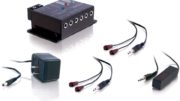Our daily lives are filled with interactions with electronics. From our mobile phones and our computers to our electric toothbrushes and coffee machines — there are devices all around us that are designed using electronic circuits. As such, it can be helpful to have an understanding of how these products work.
Whether you are looking to start a career in electronic engineering, you want to know how to fix your own devices, or you are simply a hobbyist who likes to tinker, this guide can help you learn the basics of electronic circuit design.
What are electronic circuits?
Electronic devices are named as such because they are designed with semiconductors that allow for the flow of electric charges. There are many different kinds of semiconductor devices, but the two main types are diodes and transistors, such as light-emitting diodes (LEDs) and field-effect transistors (FETs). Another more common name for these devices is electronic components.
Other electronic components that you will come across when studying circuit design include relays, resistors, inductors, capacitors, and transformers. All of these are components that are used to design electronic circuits, and the various combinations of these components are what determine the purpose of a circuit and how it behaves.
So, an electronic circuit is simply the arrangement of various electronic components that are set up in such a way to serve a specific function or task. For example, a computer often has many different circuits that are designed to help with various tasks such as allowing you to connect to the internet, communicate with satellites, to do your work, or even to play computer games.
All of these components, such as diodes, inductors, and resistors are all connected using wires, which is what allows the charge or electricity to flow between them. This flow between the connected components is what creates an electronic circuit.
Types of electronic circuits
Just as there are many different electronic components there are also a few different kinds of electronic circuits that you can make. The two main types that you will likely come across most are analog and digital.
Analog circuits
Analog circuits are designed for devices that require a continuous voltage signal or a continuous current flow, such as audio or video. The word “analog” simply means proportional. So an analog signal is a proportional signal, such as a smooth sound wave. These types of circuits often deal with more complex data because a continuous signal has more data in it.
Digital circuits
In contrast, a digital circuit isn’t continuous. Instead, it is made up of pulses, or binary ups and downs. Where an analog signal might look like a smooth wave, a digital signal will look more jagged. Because digital circuits do not deal with a continuous signal, they require less bandwidth. These types of circuits are used when more discrete signals are needed for more logical operations, such as computers and microcontrollers.
Designing electronic circuits
Though electronic circuit design is considered a complex and extensive process, we are going to break it down for you to help you get a basic understanding as a beginner.
1. Outlining the idea
The circuit design process starts with outlining the idea for the problem you want to attempt to solve with an electronic circuit. This is where you will prepare the architecture for your circuit board.
As a beginner, it can be challenging to do this from scratch, so it is helpful if you start with a pre-designed guided project that offers step-by-step instructions. Once you get the hang of how it all works, then you can start creating your own projects.
2. Translate onto a schematic
Once you have your circuit idea, you’ll want to draw it out or illustrate it by creating a schematic. This will give you an overall picture of your design so you can get a better visual of where components will need to be connected to ensure your circuit will function as intended.
3. Run a simulation
There are numerous applications for machine learning (ML) that are transforming various industries, one of which is electronic engineering. With ML technology, there are now software tools you can use to design and run simulations for your circuits.
These ML simulation tools enable you to test your circuit designs digitally first without having to physically implement them. This can help you cut back on the cost of design as the ML technology can identify errors in the circuit or ways to improve it before you waste resources creating the physical design.
4. Create a prototype
Once you think you have a functional circuit design, then you can start creating physical prototypes on a solderless breadboard to test out the simulation and see if it functions correctly in real-time. Breadboards are circuit boards that allow you to create temporary circuits to test out without needing to permanently solder the electronic components together.
5. Final PCB design
A PCB is a printed circuit board that is used to create permanent circuits. Once you are satisfied with your circuit design by testing it out with your prototype, you will then move on to create a PCB for the final circuit product. These are the green boards that you are likely familiar with that are inside almost every electronic device.
Tools for electronic circuit design
As with most projects, the key to success often lies in having the right tools to help you get the job done. For circuit design, these are the most important tools you will need to design, test, and analyze your circuits:
- Multimeter: A multimeter tool will help you measure quantities, such as voltages, currents, and resistances.
- Breadboard: Again, a breadboard is an essential tool that is used for prototyping circuits before creating the final design on a PCB.
- Connecting wires: These are the various copper wires you will need to connect the various electronic components you are using together.
- Power supply: In order to test your projects, you will need an energy source to power your circuits, such as a portable power supply box.
- Oscilloscope: An oscilloscope device will allow you to visually analyze your circuit signals so you can study the circuit behaviors and measure various parameters.
- Component kits: These kits will provide you with a selection of various components to use as you start designing circuits, such as diodes, transistors, resistors, and capacitors.
There are, of course, a number of other tools you can buy to assist you with circuit design, but these are the essentials that can help you get started. It’s better to start with a small toolkit first and then upgrade to bigger and better tools once you advance your skills and start working on bigger projects.
Wrapping up
The best way to get started with circuit design is to jump right in and start playing around with pre-designed step-by-step circuit design projects and prototypes. Using machine learning simulation software can also help you play around with things online before you start physically working with circuits in real-time.
If you are looking for circuit design tools to get you started, check out Solid Signal. We offer a wide selection of electronics products for beginners and professionals. If you have questions or need assistance, call our experts at 888-233-7563. We’re here during East Coast business hours. If it’s after hours, fill out the form below and we’ll get right back to you!





